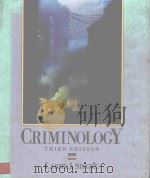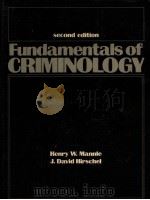《CRIMINOLOGY SECOND EDITION》
| 作者 | JOHN E.CONKLIN 编者 |
|---|---|
| 出版 | MACMILLAN PUBLISHING COMPANY |
| 参考页数 | 570 |
| 出版时间 | 1986(求助前请核对) 目录预览 |
| ISBN号 | 0023237902 — 求助条款 |
| PDF编号 | 813700658(仅供预览,未存储实际文件) |
| 求助格式 | 扫描PDF(若分多册发行,每次仅能受理1册) |

ONEPERSPECTIVES AND METHODS1
1The Study of Crime3
The Nature of Crime and Delinquency3
Basic Concepts: Norms and Deviance, Laws and Crime3
The Characteristics of Crime4
Juvenile Delinquency5
Criminal Sanctions6
Formal Laws and Informal Norms7
Social Origins of the Criminal Law8
Crime as a Social Phenomenon8
Theoretical Perspectives on the Criminal Law9
Social Sources of the Law11
The Legalistic Definition of Crime12
Criminology: The Study of Criminal Behavior13
Typologies of Criminals13
A Conceptual Approach to Criminology14
Criminal Careers15
Reactions to Crime15
Solving the Crime Problem17
Summary17
Important Terms18
Suggested Readings18
2Methods of Criminological Research19
Comparative and Historical Research19
Tobias's Study of Crime in Nineteenth-Century England20
Observation21
Humphreys" Study of Tearoom Trade22
Biographies23
Klockars's Study of a Professional Fence23
Analytic Induction24
Cressey's Study of Embezzlement25
Patterns of Crime26
Wolfgang's Study of Homicide27
The Cohort Study28
Wolfgang, Figlio, and Sellin's Cohort Study of Delinquency28
Combining Research Strategies29
Conklin's Robbery Study29
Other Strategies of Criminological Research30
Summary31
Important Terms32
Suggested Readings32
TWOTHE EXTENT AND NATURE OF CRIME33
3Measuring Crime35
The Emergence of Modern Criminology35
Classical Criminology35
Cartography36
Positivism37
Official Crime Statistics38
History of Crime Statistics in the United States38
FBI Crime Statistics39
Crime Rates41
Gathering Crime Statistics46
Using FBI Data for Criminological Research52
Measuring Criminal Victimization53
History of Victimization Surveys53
Comparing NCS and FBI Data53
The Dark Figure54
Methodological Problems with Victimization Surveys57
Other Measures of Victimization58
Measuring Crime by Self-Reports59
History of Self-Report Studies59
The Dark Figure60
Methodological Problems with Self-Report Studies61
Summary62
Important Terms63
Suggested Readings63
4The Costs of Crime65
Financial Costs of Crime65
Different Costs of Crime66
The Costs of Crime in the United States66
Physical Harm from Crime75
White-Collar Crime75
Murder75
Forcible Rape76
Aggravated Assault76
Robbery76
Narcotics77
Social Costs of Crime77
White-Collar Crime77
Government Corruption and Police Brutality78
Organized Crime79
Conventional Crime79
Summary86
Important Terms88
Suggested Readings88
5Geographic and Temporal Dimensions of Crime89
Cross-National Variations in Crime Rates89
Japan90
China90
Canada91
Cross-National Comparisons of Murder Rates92
Regional Variations in Crime Rates within the United States92
Variations in Crime Rates by Size of Community94
Official Crime Statistics94
Victimization Surveys96
Crime within Metropolitan Areas97
Migration, Population Density, and Crime99
Temporal Variations in Crime Rates102
Crime and Day of the Week and Hour of the Day103
Crime and Seasons of the Year103
Annual Trends in Crime Rates104
Summary108
Important Terms109
Suggested Readings109
6Social Dimensions of Crime111
Variations in Crime Rates by Sex111
Sex and Juvenile Delinquency111
Sex and Adult Crime113
Sex and Victimization117
Variations in Crime Rates by Age117
Age-Specific Arrest Rates117
Age Distribution and Crime Rates119
Age and Victimization121
Variations in Crime Rates by Race121
Race, Arrest Statistics, and Self-Report Studies123
Race, Crime, and Background Variables124
Race and Victimization125
Variations in Crime Rates by Class126
Class and Adult Crime126
Class and Juvenile Delinquency127
Methodological Problems129
Class and Victimization130
Summary132
Important Terms133
Suggested Readings133
THREETHE CAUSES OF CRIMINAL BEHAVIOR135
7Biological and Psychological Causes of Crime137
Biological Explanations of Crime137
History of the Biological Perspective on Crime137
Modern Biological Research on Crime139
Biology and Modern Criminology145
Psychological Explanations of Crime146
Mental Deficiency Theory146
Personality Characteristics150
The Psychoanalytic Perspective156
Conditioning Theory159
Psychology and Variations in Crime Rates159
Psychology and the Criminal Law160
Summary164
Important Terms166
Suggested Readings166
8Socioeconomic Causes of Crime167
Socioeconomic Causes of White-Collar Crime167
Free Enterprise: Profits and Competition168
Market Structure and Crime169
Trust and Credit171
Corporations and Crime171
Development of New Technology173
Socioeconomic Causes of Organized Crime174
Prohibition and Organized Crime174
Organized Crime after Prohibition175
Organized Crime and the Economic System177
Socioeconomic Causes of Conventional Crime177
Modernization and Crime178
Opportunity and the Economy178
Unemployment and Crime179
Relative Deprivation and Crime180
Anomie and Crime181
Differential Opportunity and Delinquency185
Class, Values, and Delinquency187
Opportunity, Values, and Class: An Evaluation of Delinquency Theories190
The Subculture of Violence193
Socioeconomic Factors and Variations in Crime Rates197
Summary199
Important Terms200
Suggested Readings201
9Social Control and Commitment to the Law202
Neutralizing the Law202
Drift202
Delinquent, Dominant, and Subterranean Values203
Techniques of Neutralization203
Evidence on Techniques of Neutralization209
Embezzlement and the Techniques of Neutralization209
Justifications for Crime by Blacks210
Jastifying Murder210
Delinquency and Techniques of Neutralization211
Critique of Neutralization Theory212
Control Theory213
The Family214
The School214
The Peer Group214
Conventional Lines of Action and Adult Activities215
Evidence on Control Theory216
Comparing Delinquents and Nondelinquents216
Delinquency and the Family217
Delinquency and the School223
Delinquency and the Peer Group224
Delinquency and Religion225
Migration and the Disruption of Social Bonds226
Social Bonds in Other Societies227
Critique of Control Theory230
Techniques of Neutralization, Control Theory, and Variations in Crime Rates230
Summary232
Important Terms233
Suggested Readings233
10Learning to Commit Crime234
Sources of Learning to Commit Crime234
The Community234
Delinquent Gangs and Peer Groups235
The General Culture235
The Mass Media236
Pornography239
Correctional Institutions240
Differential Association Theory241
Principles of Differential Association Theory241
Critique of Differential Association Theory243
Modifications of Differential Association Theory244
Evidence on Differential Association Theory245
The Labeling Perspective249
Labeling and Self-Concepts250
Labeling and Opportunities254
Labeling and Subcultures255
Critique of the Labeling Perspective256
Rewards and Risks of Crime257
Operant Conditioning and Crime257
The Economist's Model of Criminal Behavior257
The Risks and Rewards of Crime260
Critique of the Rewards-Risks Model265
Learning Theories and Variations in Crime Rates265
Summary266
Important Terms268
Suggested Readings268
11Opportunity and Organization to Commit Crime269
The Routine Activities Approach269
A Critique of the Routine Activities Approach270
Targets of Crime270
Property Crimes271
Vulnerability of Victims272
Victim-Offender Relationships275
Social Characteristics of Victims and Offenders275
Relationships between Victims and Offenders277
Victim Precipitation280
Facilitating Factors: Alcohol, Drugs, and Firearms283
Alcohol and Crime283
Drugs and Crime285
Firearms and Crime286
Planning Crime292
Forcible Rape292
Shoplifting292
Burglary293
Robbery293
White-Collar Crime294
The Organization of Criminal Behavior294
Professional Theft294
Organized Crime296
Summary299
Important Terms300
Suggested Readings300
12Criminal Careers301
Analyzing Criminal Careers303
Career Contingencies303
The Labeling Perspective303
The "Zigzag Path": Criminal Careers and Legitimate Pursuits304
Recruitment into a Criminal Career304
Typologies of Criminal Careers305
Delinquent Careers308
Chronic Offenders309
Patterns of Delinquent Careers309
Juvenile Delinquency and Adult Criminal Careers310
Adult Criminal Careers312
Career Patterns312
Planning Crimes313
Use of the Stolen Money313
Intensive and Intermittent Career Criminals314
Leaving a Life of Crime315
Reasons for Leaving a Career as a Professional Thief316
Reasons for Leaving a Career as a Drug Dealer or Smuggler317
Exiting and Theories of Crime Causation319
Exiting and the Correctional System319
Summary320
Important Terms321
Suggested Readings321
FOURREACTIONS TO CRIME323
13Community Reactions to Crime325
Informal Control of Crime325
Community and Informal Social Control326
Architecture and Informal Social Control329
Individual Response to Crime332
Bystander Responses to Crime332
Collective Response to Crime336
A Historical and Comparative Perspective336
Urban Patrol Groups338
Community Crime-Prevention Strategies341
Community Reactions to Offenders341
Isolating the Offender342
Community-Based Corrections342
Summary344
Important Terms345
Suggested Readings345
14The Criminal Justice System346
The Police349
History of the Police349
Organization of the Police350
The Working Personality of the Officer352
The Clearance Rate357
The Courts359
Bail and Preventive Detention359
Prosecutors361
Defense Attorneys362
Judges363
Juries363
Plea Bargaining364
Probation365
Sentence Disparity365
The Prisons370
History of Prisons370
Prison Overcrowding371
Prison Riots372
The Prisoners' Rights Movement373
Prisons and Race374
Parole375
The Victim in the Criminal Justice System375
Compensation376
Restitution376
The Changing Role of the Victim377
Summary378
Important Terms379
Suggested Readings379
15Deterrence and Incapacitation380
The Deterrence Model380
History of the Idea of Deterrence380
Assumptions about Behavior381
Deterrence and Other Effects of Penalties381
Specific and General Deterrence383
Absolute, Restrictive, and Marginal Deterrence383
Deterrence and the Criminal Act384
A Typology of Crime Deterrence384
Deterrence and Conventional Crime385
Deterrence and White-Collar Crime386
Deterrence and Tax Evasion387
Deterrence and the Sanctioning Process388
Severity of Punishment388
Certainty of Punishment389
Certainty, Severity, and Informal Sanctions391
Promptness of Punishment392
Types of Punishment393
Deterrence and the Criminal Justice System394
Deterrence and the Police394
Deterrence and the Courts399
Deterrence and the Prisons400
Deterrence and Capital Punishment401
Incapacitation405
Types of Incapacitation406
Summary409
Important Terms410
Suggested Readings410
16Retribution412
The Retribution Model412
Retribution and Vengeance413
Retribution Compared to Deterrence and Rehabilitation413
A System of Just Deserts415
The Seriousness of Crimes415
The Unpleasantness of Penalties422
Linking Penalties to Crimes423
Retribution and the Criminal Justice System425
Retribution and the Police425
Retribution and the Courts425
Retribution and the Prisons428
Retribution and Capital Punishment428
Summary431
Important Terms432
Suggested Readings432
17Rehabilitation433
The Rehabilitation Model433
Historical Background433
Assumptions Underlying Rehabilitation435
Rehabilitation Compared to Retribution and Deterrence437
Rehabilitation and the Criminal Justice System438
Rehabilitation and the Police438
Rehabilitation and the Courts439
Rehabilitation and the Prisons440
Does Rehabilitation Work?441
Measuring the Success of Treatment Programs441
Types of Treatment444
Testing the Effects of a Group Counseling Program447
The Effectiveness of Treatment Methods449
The Future of Rehabilitation454
Summary455
Important Terms456
Suggested Readings456
18Solving the Crime Problem458
Ideological Approaches to Solving the Crime Problem458
The Conservative Approach458
The Liberal Approach459
The Radical Approach459
The Politics of Crime460
The President's Commission on Law Enforcement and Administration of Justice460
The Law Enforcement Assistance Administration461
The 1968 and 1972 Presidential Elections462
The National Advisory Commission on Criminal Justice Standards and Goals462
The Crime Issue during the Reagan Administration463
Crime and the Criminal Justice System464
Overreach of the Criminal Law465
The Police465
The Courts467
The Prisons469
Situational Crime Prevention470
Target Hardening470
Self-Protective Measures472
Informal Social Control472
Community Crime Prevention473
Dealing with the Causes of Crime474
Economic Factors474
The Process of Social Change476
Political Factors477
Community Ties477
The Family477
The School479
Discrimination480
Conclusion480
Summary480
Important Terms482
Suggested Readings482
Important Terms483
Bibliography492
Name Index549
Subject Index559
1986《CRIMINOLOGY SECOND EDITION》由于是年代较久的资料都绝版了,几乎不可能购买到实物。如果大家为了学习确实需要,可向博主求助其电子版PDF文件(由JOHN E.CONKLIN 1986 MACMILLAN PUBLISHING COMPANY 出版的版本) 。对合法合规的求助,我会当即受理并将下载地址发送给你。
高度相关资料
-

- CRIMINOLOGY AN INTRODUCTION THROUGH MICROCASE SECOND EDITION
- 1992 MICROCASE CORPORATION
-

- CRIMINOLOGY 98/99 SECOND EDITION
- 1998年 DUSHKIN/MCGRAW-HILL
-

- Criminology
- 1998 Butterworths
-

- CRIMINOLOGY THIRD EDITION
- 1989 COPYRIGHT
-

- CRITICAL CRIMINOLOGY
- 1975 ROUTLEDGE AND KEGAN PAUL
-

- CRIMINOLOGY THE SHORTER VERSION THIRD EDITION
- 1998 MCGRAW-HILL
-

- FUNDAMENTALS OF CRIMINOLOGY 2ND EDITION
- 1988 PRENTICE HALL
-

- Environmental criminology
- 1981 Sage publications
-

- CRIMINOLOGY SECOND EDITION
- 1986 MACMILLAN PUBLISHING COMPANY
-

- Criminology
- 1984 McGraw-Hill
-

- PRINCIPLES OF CRIMINOLOGY SIXTH EDITION
- 1960 J.B.LIPPINCOTT COMPANY
-

- CRIMINOLOGY SECOND EDITION
- 1995 HARCOURT BRACE COLLEGE PUBLISHERS
提示:百度云已更名为百度网盘(百度盘),天翼云盘、微盘下载地址……暂未提供。➥ PDF文字可复制化或转WORD


